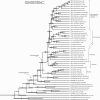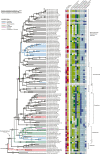Invertebrate and avian predators as drivers of chemical defensive strategies in tenthredinid sawflies
- PMID: 24041372
- PMCID: PMC3848831
- DOI: 10.1186/1471-2148-13-198
Invertebrate and avian predators as drivers of chemical defensive strategies in tenthredinid sawflies
Abstract
Background: Many insects are chemically defended against predatory vertebrates and invertebrates. Nevertheless, our understanding of the evolution and diversity of insect defenses remains limited, since most studies have focused on visual signaling of defenses against birds, thereby implicitly underestimating the impact of insectivorous insects. In the larvae of sawflies in the family Tenthredinidae (Hymenoptera), which feed on various plants and show diverse lifestyles, two distinct defensive strategies are found: easy bleeding of deterrent hemolymph, and emission of volatiles by ventral glands. Here, we used phylogenetic information to identify phylogenetic correlations among various ecological and defensive traits in order to estimate the relative importance of avian versus invertebrate predation.
Results: The mapping of 12 ecological and defensive traits on phylogenetic trees inferred from DNA sequences reveals the discrete distribution of easy bleeding that occurs, among others, in the genus Athalia and the tribe Phymatocerini. By contrast, occurrence of ventral glands is restricted to the monophyletic subfamily Nematinae, which are never easy bleeders. Both strategies are especially effective towards insectivorous insects such as ants, while only Nematinae species are frequently brightly colored and truly gregarious. Among ten tests of phylogenetic correlation between traits, only a few are significant. None of these involves morphological traits enhancing visual signals, but easy bleeding is associated with the absence of defensive body movements and with toxins occurring in the host plant. Easy bleeding functions through a combination of attributes, which is corroborated by an independent contrasts test indicating a statistically significant negative correlation between species-level integument mechanical resistance and hemolymph feeding deterrence against ants.
Conclusions: Our analyses evidence a repeated occurrence of easy bleeding, and no phylogenetic correlation including specific visual signals is significant. We conclude that the evolution of chemically-based defenses in tenthredinids may have been driven by invertebrate as much as by avian predation. The clear-cut visual signaling often encountered in the Nematinae would be linked to differential trends of habitat use by prey and predators. Further studies on (prey) insect groups should include visual signals and other traits, as well as several groups of natural enemies, to better interpret their relative significance and to refine our understanding of insect chemical defenses.
Figures




Similar articles
-
Why does the larval integument of some sawfly species disrupt so easily? The harmful hemolymph hypothesis.Oecologia. 2003 Jan;134(1):104-11. doi: 10.1007/s00442-002-1092-4. Epub 2002 Nov 7. Oecologia. 2003. PMID: 12647187
-
Endogenous toxins and the coupling of gregariousness to conspicuousness in Argidae and Pergidae sawflies.Sci Rep. 2018 Dec 5;8(1):17636. doi: 10.1038/s41598-018-35925-z. Sci Rep. 2018. PMID: 30518939 Free PMC article.
-
Searching for particular traits of sawfly (Hymenoptera: Tenthredinidae) larvae that emit hemolymph as a defence against predators.J Insect Physiol. 2017 Jan;96:93-97. doi: 10.1016/j.jinsphys.2016.10.012. Epub 2016 Oct 20. J Insect Physiol. 2017. PMID: 27773636
-
Insect pathogens as biological control agents: Back to the future.J Invertebr Pathol. 2015 Nov;132:1-41. doi: 10.1016/j.jip.2015.07.009. Epub 2015 Jul 27. J Invertebr Pathol. 2015. PMID: 26225455 Review.
-
How do predators cope with chemically defended foods?Biol Bull. 2007 Dec;213(3):252-66. doi: 10.2307/25066643. Biol Bull. 2007. PMID: 18083965 Review.
Cited by
-
Mitochondrial Phylogenomics of Tenthredinidae (Hymenoptera: Tenthredinoidea) Supports the Monophyly of Megabelesesinae as a Subfamily.Insects. 2021 May 26;12(6):495. doi: 10.3390/insects12060495. Insects. 2021. PMID: 34073280 Free PMC article.
-
Chemical composition: Hearing insect defensive volatiles.Patterns (N Y). 2021 Sep 23;2(11):100352. doi: 10.1016/j.patter.2021.100352. eCollection 2021 Nov 12. Patterns (N Y). 2021. PMID: 34820644 Free PMC article.
-
Step-wise evolution of complex chemical defenses in millipedes: a phylogenomic approach.Sci Rep. 2018 Feb 16;8(1):3209. doi: 10.1038/s41598-018-19996-6. Sci Rep. 2018. PMID: 29453332 Free PMC article.
-
Furostanol Saponins and Ecdysteroids from Plants of the Genus Helleborus as Phagostimulants and Predator Deterrents for Larvae of Two Monophadnus Sawfly Species.Plants (Basel). 2024 Aug 12;13(16):2230. doi: 10.3390/plants13162230. Plants (Basel). 2024. PMID: 39204666 Free PMC article.
-
Toxic peptides occur frequently in pergid and argid sawfly larvae.PLoS One. 2014 Aug 14;9(8):e105301. doi: 10.1371/journal.pone.0105301. eCollection 2014. PLoS One. 2014. PMID: 25121515 Free PMC article.
References
-
- Schoenly K. The predators of insects. Ecol Entomol. 1990;15:333–345. doi: 10.1111/j.1365-2311.1990.tb00815.x. - DOI
-
- Jervis M, Kidd N. Insect Natural Enemies. Practical Approaches to their Study and Evaluation. London: Chapman & Hall; 1996.
-
- Blum MS. Chemical Defenses of Arthropods. New York: Academic Press; 1981.
-
- Whitman DW, Blum MR, Alsop DW. In: Insect Defenses: Adaptive Mechanisms and Strategies of Prey and Predators. Evans DL, Schmidt JO, editor. Albany, N.Y: State University of New York Press; 1990. Allomones: Chemicals for defense; pp. 289–351.
-
- Eisner T, Eisner M, Siegler M. Secret Weapons: Defenses of Insects, Spiders, Scorpions, and other Many-Legged Creatures. Cambridge (MA): Harvard University Press; 2005.
Publication types
MeSH terms
LinkOut - more resources
Full Text Sources
Other Literature Sources
Molecular Biology Databases

